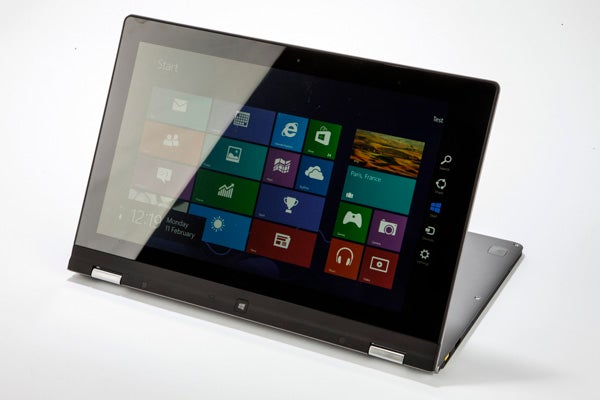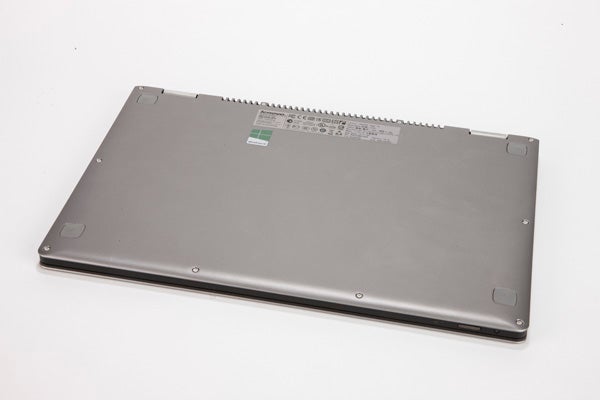Lenovo IdeaPad Yoga 13 Review - Battery, Value and Verdict Review
Battery, Value and Verdict
Is this flexible flip-screen convertible the ideal marriage of Ultrabook and tablet?

Sections
- Page 1 Lenovo IdeaPad Yoga 13 Review
- Page 2 Connectivity, Usability, Touch and Tablet Review
- Page 3 Screen, Speakers and Specs Review
- Page 4 Battery, Value and Verdict Review
Lenovo IdeaPad Yoga 13 – Battery Life
The Lenovo Yoga 13 nearly tops the battery-life ranks out of the Core i-based convertibles we have tested so, far with 5 hours and 19 minutes – though that’s hardly much of an achievement considering how poor battery life has generally been for these kind of machines. Only the Toshiba Satellite U920t beats it with 5 hours and 43 minutes, but that’s with a Core i5 CPU rather than this Yoga’s Core i7.
(u)Battery Result(/u)
(40 percent screen brightness, mixed productivity and web-browsing)
5 hours 19 minutes
As this Powermark benchmark includes web-browsing, you can generally expect a little longer with careful use, but either way the IdeaPad Yoga 13 falls short of Lenovo’s eight-hour claims. Still, it’s a positively superb result compared to the four-ish hours of the likes of the Acer Aspire S7 13-inch. 
Lenovo IdeaPad Yoga 13 – Price
Considering how many convertibles can be found for around £1,000 these days, the £999 Lenovo Yoga 13 certainly isn’t suffering from lack of competition. However, it does hold up well overall, especially if you’re specifically after a laptop/tablet hybrid of 13-inches. 
Compared to the £850 Toshiba Satellite U920t, our Yoga offers a higher-resolution, better quality display, a far nicer keyboard and a lot more processing power, though it loses out when it comes to battery life and portability. Still, considering how much more flexible the Yoga’s form factor is too, Lenovo would probably get our money here.
With Lenovo’s own more enterprise-oriented ThinkPad Twist S230U, it’s a case of horses for courses. The Twist is much nicer to type on and offers optional 3G, but even on the £1,080 version you get a lower-res screen and far inferior battery life – meaning that, once again, most consumers are better off going Yoga.
On the other hand, for this kind of money it may be worth hanging on to your pennies till the next generation of convertibles arrive as, while the Lenovo IdeaPad Yoga 13 certainly impresses as a laptop, it leaves a little to be desired as a tablet and doesn’t come with a stylus (which is handy for ‘classic’ Windows navigation even if you’re not into handwriting, image editing or drawing). Even the Windows 8 version of the 11-inch IdeaPad Yoga 11 may be a better bet, as it will doubtless be lighter.
Verdict
Like most of the Windows 8 convertible tablet/laptops we’ve looked at, the Lenovo IdeaPad Yoga 13 isn’t quite the perfect hybrid. However, if you regard it as a touch-screen Ultrabook with a cool twist, it certainly succeeds. It’s generally well-built, looks stylish and feels great, and its flexible hinge gives you lots of different usage scenarios. While no match for the ThinkPad range, its keyboard is pleasant enough to type on and its touchpad is lovely, while that 1,600 x 900 IPS screen supports 10-finger touch. It also has plenty of power under the hood, and backs this with decent battery life. If a more affordable Core i3/i5 version becomes available in the UK, it’ll be a steal.
How we test tablets
We test every tablet we review thoroughly. We use industry standard tests to compare features properly and we use the tablet as our main device over the review period. We’ll always tell you what we find and we never, ever, accept money to review a product.
Trusted Score
Score in detail
-
Performance 8
-
Design 9
-
Screen Quality 8
-
Value 8
-
Features 8
-
Battery Life 7

